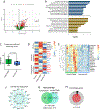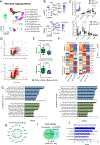Single-nucleus RNA sequencing demonstrates an autosomal dominant Alzheimer's disease profile and possible mechanisms of disease protection
- PMID: 38417436
- PMCID: PMC11156559
- DOI: 10.1016/j.neuron.2024.02.009
Single-nucleus RNA sequencing demonstrates an autosomal dominant Alzheimer's disease profile and possible mechanisms of disease protection
Abstract
Highly penetrant autosomal dominant Alzheimer's disease (ADAD) comprises a distinct disease entity as compared to the far more prevalent form of AD in which common variants collectively contribute to risk. The downstream pathways that distinguish these AD forms in specific cell types have not been deeply explored. We compared single-nucleus transcriptomes among a set of 27 cases divided among PSEN1-E280A ADAD carriers, sporadic AD, and controls. Autophagy genes and chaperones clearly defined the PSEN1-E280A cases compared to sporadic AD. Spatial transcriptomics validated the activation of chaperone-mediated autophagy genes in PSEN1-E280A. The PSEN1-E280A case in which much of the brain was spared neurofibrillary pathology and harbored a homozygous APOE3-Christchurch variant revealed possible explanations for protection from AD pathology including overexpression of LRP1 in astrocytes, increased expression of FKBP1B, and decreased PSEN1 expression in neurons. The unique cellular responses in ADAD and sporadic AD require consideration when designing clinical trials.
Keywords: APOE3 Christchurch; PSEN1-E280A; autophagy; chaperones; single-nucleus sequencing; spatial transcriptomics; sporadic Alzheimer's disease; transcriptomics.
Copyright © 2024 Elsevier Inc. All rights reserved.
Conflict of interest statement
Declaration of interests K.S.K. consults for ADRx and Expansion Therapeutics and is a member of the Tau Consortium board of directors. F.L. consults for Biogen and Viewmind and has grants from the NIH, Red-Lat, Alzheimer’s Association, Biogen, DIAN-TU, DIAN-Obs, Large PD, and Enroll-HD. J.A.-U .is a consultant for the pharmaceutical company Tecnoquimicas (Colombia).
Figures







References
-
- Cruchaga C, Del-Aguila JL, Saef B, Black K, Fernandez MV, Budde J, Ibanez L, Deming Y, Kapoor M, Tosto G, et al. (2018). Polygenic risk score of sporadic late-onset Alzheimer’s disease reveals a shared architecture with the familial and early-onset forms. Alzheimer’s & Dementia 14, 205–214. 10.1016/j.jalz.2017.08.013. - DOI - PMC - PubMed
-
- Acosta-Baena N, Sepulveda-Falla D, Lopera-Gómez CM, Jaramillo-Elorza MC, Moreno S, Aguirre-Acevedo DC, Saldarriaga A, and Lopera F (2011). Pre-dementia clinical stages in presenilin 1 E280A familial early-onset Alzheimer’s disease: a retrospective cohort study. The Lancet Neurology 10, 213–220. 10.1016/S1474-4422(10)70323-9. - DOI - PubMed
-
- Lopera F, Ardilla A, Martínez A, Madrigal L, Arango-Viana JC, Lemere CA, Arango-Lasprilla JC, Hincapié L, Arcos-Burgos M, Ossa JE, et al. (1997). Clinical Features of Early-Onset Alzheimer Disease in a Large Kindred With an E280A Presenilin-1 Mutation. JAMA 277, 793–799. 10.1001/jama.1997.03540340027028. - DOI - PubMed
MeSH terms
Substances
Grants and funding
LinkOut - more resources
Full Text Sources
Medical
Molecular Biology Databases
Miscellaneous

